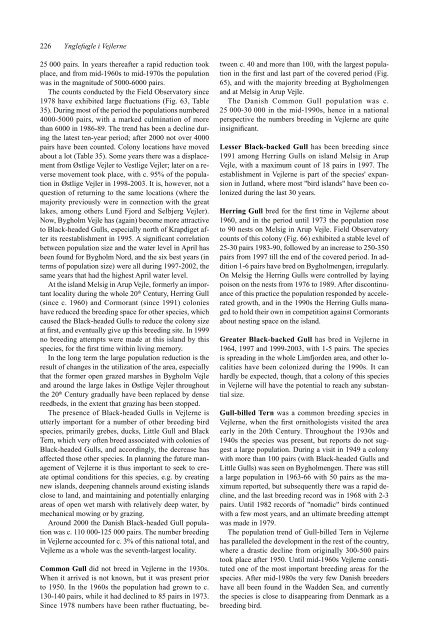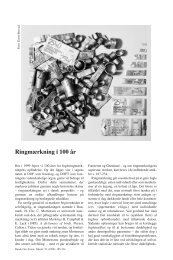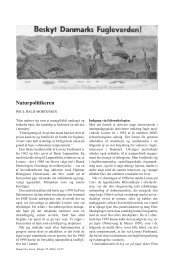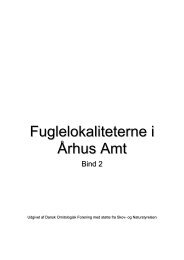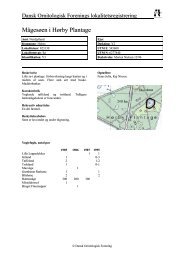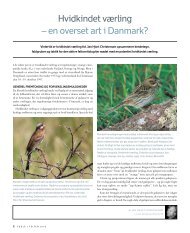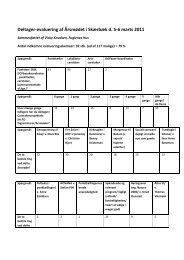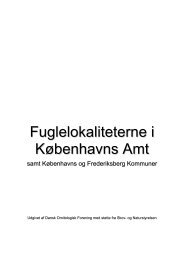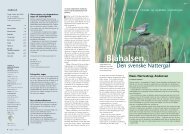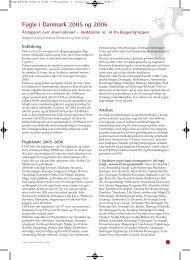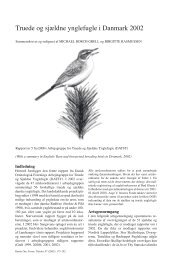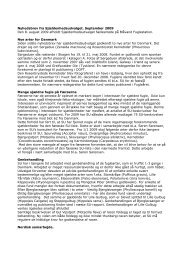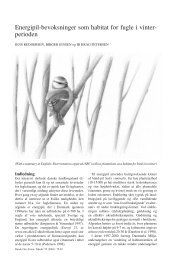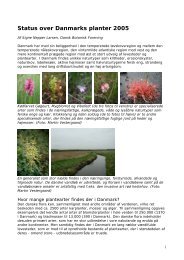Ynglefugle i Vejlerne - Dansk Ornitologisk Forening
Ynglefugle i Vejlerne - Dansk Ornitologisk Forening
Ynglefugle i Vejlerne - Dansk Ornitologisk Forening
Create successful ePaper yourself
Turn your PDF publications into a flip-book with our unique Google optimized e-Paper software.
226 <strong>Ynglefugle</strong> i <strong>Vejlerne</strong><br />
25.000 pairs. In years thereafter a rapid reduction took<br />
place, and from mid-1960s to mid-1970s the population<br />
was in the magnitude of 5000-6000 pairs.<br />
The counts conducted by the Field Observatory since<br />
1978 have exhibited large uctuations (Fig. 63, Table<br />
35). During most of the period the populations numbered<br />
4000-5000 pairs, with a marked culmination of more<br />
than 6000 in 1986-89. The trend has been a decline during<br />
the latest ten-year period; after 2000 not over 4000<br />
pairs have been counted. Colony locations have moved<br />
about a lot (Table 35). Some years there was a displacement<br />
from Østlige Vejler to Vestlige Vejler; later on a reverse<br />
movement took place, with c. 95% of the population<br />
in Østlige Vejler in 1998-2003. It is, however, not a<br />
question of returning to the same locations (where the<br />
majority previously were in connection with the great<br />
lakes, among others Lund Fjord and Selbjerg Vejler).<br />
Now, Bygholm Vejle has (again) become more attractive<br />
to Black-headed Gulls, especially north of Krapdiget after<br />
its reestablishment in 1995. A signicant correlation<br />
between population size and the water level in April has<br />
been found for Bygholm Nord, and the six best years (in<br />
terms of population size) were all during 1997-2002, the<br />
same years that had the highest April water level.<br />
At the island Melsig in Arup Vejle, formerly an important<br />
locality during the whole 20 th Century, Herring Gull<br />
(since c. 1960) and Cormorant (since 1991) colonies<br />
have reduced the breeding space for other species, which<br />
caused the Black-headed Gulls to reduce the colony size<br />
at rst, and eventually give up this breeding site. In 1999<br />
no breeding attempts were made at this island by this<br />
species, for the rst time within living memory.<br />
In the long term the large population reduction is the<br />
result of changes in the utilization of the area, especially<br />
that the former open grazed marshes in Bygholm Vejle<br />
and around the large lakes in Østlige Vejler throughout<br />
the 20 th Century gradually have been replaced by dense<br />
reedbeds, in the extent that grazing has been stopped.<br />
The presence of Black-headed Gulls in <strong>Vejlerne</strong> is<br />
utterly important for a number of other breeding bird<br />
species, primarily grebes, ducks, Little Gull and Black<br />
Tern, which very often breed associated with colonies of<br />
Black-headed Gulls, and accordingly, the decrease has<br />
affected those other species. In planning the future management<br />
of <strong>Vejlerne</strong> it is thus important to seek to create<br />
optimal conditions for this species, e.g. by creating<br />
new islands, deepening channels around existing islands<br />
close to land, and maintaining and potentially enlarging<br />
areas of open wet marsh with relatively deep water, by<br />
mechanical mowing or by grazing.<br />
Around 2000 the Danish Black-headed Gull population<br />
was c. 110.000-125.000 pairs. The number breeding<br />
in <strong>Vejlerne</strong> accounted for c. 3% of this national total, and<br />
<strong>Vejlerne</strong> as a whole was the seventh-largest locality.<br />
Common Gull did not breed in <strong>Vejlerne</strong> in the 1930s.<br />
When it arrived is not known, but it was present prior<br />
to 1950. In the 1960s the population had grown to c.<br />
130-140 pairs, while it had declined to 85 pairs in 1973.<br />
Since 1978 numbers have been rather uctuating, be-<br />
tween c. 40 and more than 100, with the largest population<br />
in the rst and last part of the covered period (Fig.<br />
65), and with the majority breeding at Bygholmengen<br />
and at Melsig in Arup Vejle.<br />
The Danish Common Gull population was c.<br />
25.000-30.000 in the mid-1990s, hence in a national<br />
perspective the numbers breeding in <strong>Vejlerne</strong> are quite<br />
insignicant.<br />
Lesser Black-backed Gull has been breeding since<br />
1991 among Herring Gulls on island Melsig in Arup<br />
Vejle, with a maximum count of 18 pairs in 1997. The<br />
establishment in <strong>Vejlerne</strong> is part of the species' expansion<br />
in Jutland, where most "bird islands" have been colonized<br />
during the last 30 years.<br />
Herring Gull bred for the rst time in <strong>Vejlerne</strong> about<br />
1960, and in the period until 1973 the population rose<br />
to 90 nests on Melsig in Arup Vejle. Field Observatory<br />
counts of this colony (Fig. 66) exhibited a stable level of<br />
25-30 pairs 1983-90, followed by an increase to 250-350<br />
pairs from 1997 till the end of the covered period. In addition<br />
1-6 pairs have bred on Bygholmengen, irregularly.<br />
On Melsig the Herring Gulls were controlled by laying<br />
poison on the nests from 1976 to 1989. After discontinuance<br />
of this practice the population responded by accelerated<br />
growth, and in the 1990s the Herring Gulls managed<br />
to hold their own in competition against Cormorants<br />
about nesting space on the island.<br />
Greater Black-backed Gull has bred in <strong>Vejlerne</strong> in<br />
1964, 1997 and 1999-2003, with 1-5 pairs. The spe cies<br />
is spreading in the whole Limfjorden area, and other localities<br />
have been colonized during the 1990s. It can<br />
hardly be expected, though, that a colony of this species<br />
in <strong>Vejlerne</strong> will have the potential to reach any substantial<br />
size.<br />
Gull-billed Tern was a common breeding species in<br />
<strong>Vejlerne</strong>, when the rst ornithologists visited the area<br />
early in the 20th Century. Throughout the 1930s and<br />
1940s the species was present, but reports do not suggest<br />
a large population. During a visit in 1949 a colony<br />
with more than 100 pairs (with Black-headed Gulls and<br />
Little Gulls) was seen on Bygholmengen. There was still<br />
a large population in 1963-66 with 50 pairs as the maximum<br />
reported, but subsequently there was a rapid decline,<br />
and the last breeding record was in 1968 with 2-3<br />
pairs. Until 1982 records of "nomadic" birds continued<br />
with a few most years, and an ultimate breeding attempt<br />
was made in 1979.<br />
The population trend of Gull-billed Tern in <strong>Vejlerne</strong><br />
has paralleled the development in the rest of the country,<br />
where a drastic decline from originally 300-500 pairs<br />
took place after 1950. Until mid-1960s <strong>Vejlerne</strong> constituted<br />
one of the most important breeding areas for the<br />
species. After mid-1980s the very few Danish breeders<br />
have all been found in the Wadden Sea, and currently<br />
the species is close to disappearing from Denmark as a<br />
breeding bird.


